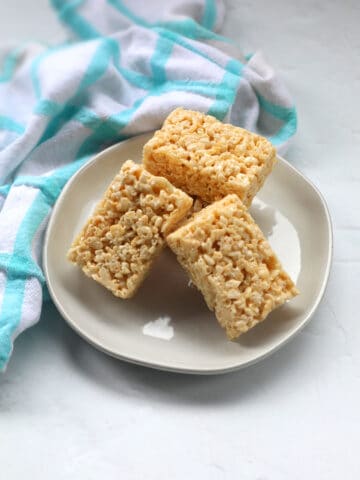Soft, salty, with a delicately crispy crust, fresh focaccia bread is perfect for dipping in olive oil and balsamic vinegar. But how do you keep it tasting fresh after you bake it? Here’s how to store focaccia bread properly so you can enjoy it for longer.

Homemade focaccia bread is a versatile and tasty addition to any meal. Not only can you add a variety of toppings similar to a more traditional flatbread, focaccia can also be a great side dish all on its own. And the herbiness pairs perfectly with a glass of Pinot Noir or Cabernet.
The key is helping it stay fresh as long as possible. Here are the best ways to store your focaccia.
Jump to:
What is focaccia?
Focaccia is a type of Italian flatbread made with dough that is coated in olive oil and herbs like fresh rosemary, then baked at high heat (between 425° and 475° Fahrenheit). The result is a soft, slightly crunchy bread with an herby, olive oil taste. The high levels of oil also act as a preservative, helping prevent the bread from going stale quickly.
How to store focaccia
Storing at room temperature
If you plan on eating your delicious focaccia bread soon after you bake it, the best way to store it is at room temperature. Simply place it in an airtight container and leave it in a dry place like a pantry or on a kitchen countertop, out of direct sunlight.
If you don’t have a suitable container, you can cut the focaccia into pieces and wrap them in plastic wrap, then aluminum foil, and place them in a large plastic bag such as a freezer bag.
If stored in an airtight container or plastic bag, focaccia bread should keep fresh for 2-3 days at room temperature.
Storing in the freezer
In order to save your focaccia bread for longer periods of time, it’s best to freeze it. Start by flash-freezing your bread. Here’s how:
Once your bread is done baking and has cooled, cut it into pieces. Then line a baking sheet with parchment paper and place the focaccia on it in a single layer. Put it in the freezer for a couple of hours.
After the bread is flash-frozen, use plastic wrap to seal each individual piece. Then store them in freezer-safe bags like a ziploc bag, or in an air-tight container, and make sure they’re tightly sealed. This will help prevent freezer burn and keep out odors from other food items in the freezer.
Focaccia will keep for up to 1 month in the freezer if stored and sealed in an airtight container.
Don’t store focaccia in the fridge
You should avoid storing your freshly baked focaccia in the refrigerator. Though it will extend the shelf life of the bread, you may sacrifice flavor and texture. That’s because even if you keep it in an airtight container, the cool environment can give the bread an unpleasantly chewy feel and make it go stale more quickly.
The exception: if you’ve topped your bread with perishable ingredients like meats, cheeses, or fresh vegetables like tomatoes, you’ll want to refrigerate it in a sealed container so those foods don’t go bad.
In these cases, it’s best to only store in it the fridge for a short time — like prepping it with toppings the night before you plan to serve it the following day.
How to reheat focaccia bread

Now, far be it from me to tell you how to enjoy your focaccia, but if you’ve frozen or refrigerated it, chances are you’ll want to warm it up before you start eating it. Because warm homemade bread just tastes better! Here are a few ways to reheat your bread.
Reheating focaccia in the oven
The best method for reheating focaccia is in the oven. First, if the bread is frozen, remove the slices you want to warm up from the freezer and let them thaw at room temperature in their original plastic wrap.
Once defrosted — or if you’re simply taking it from the fridge — place the bread on a baking sheet and spray it with a bit of water. This will open up the bread and help keep it from drying out in the oven.
Heat the focaccia at 375° Fahrenheit for 5-6 minutes or until the bread is crispy and hot.
Using a toaster
While the oven is a great way to warm up your focaccia evenly, another option is to use a toaster. Whether it’s frozen or simply chilled from the fridge, just drop your slices into the toaster and warm them up at medium heat. You should have warm and crispy bread in a few minutes.
If it’s still cold in the center (especially if taken from the freezer), try toasting it again at low heat, being careful not to burn the outside.
Using a microwave
A third option for reheating your focaccia is the microwave. If your focaccia is frozen, let it thaw at room temperature first. Once your bread is defrosted or if you’re taking it from the fridge, place it on a microwave-safe plate or damp paper towel. Then microwave it for 30 seconds. Repeat at 15-second intervals until done.
Now, while you can heat up focaccia in the microwave, there are some drawbacks to this method. You’ll likely end up with overly-soft bread that may be hard to chew. And you won’t get the crispy exterior that helps make focaccia so special.
How to store focaccia dough
While you shouldn’t store finished focaccia bread in the fridge, it is a good idea to let focaccia dough rest in the fridge overnight before you bake it.
Storing it in the fridge for several hours delays the fermentation process in the yeast and helps richer flavors develop, so you get great focaccia.

When your dough is ready to store, transfer it to a large bowl coated in extra virgin olive oil. Cover with a lid and let it rise in the refrigerator until it doubles in size. For best results, let it do this initial rise for about 12 hours.
Once it’s completed the first rise, move the dough to a bread pan for baking that’s lined with butter and olive oil. Then let the dough rise in a warm place (if your oven has a “proof” setting, you can let it do the second rise there) for another 2-3 hours.
Note: If you’re in a time crunch, you can use active dry yeast mixed with warm water in your focaccia dough. This will help it rise more quickly, so your bread should be ready to bake in a couple of hours instead.
Once the dough is finished rising, it’s ready to be formed into a flat loaf in the prepared pan and baked.

Storing Frozen Focaccia Dough
You can also freeze focaccia dough if you want to prepare it ahead of time and use it later.
Once you make the dough, let it do an initial rise as noted above. Once risen, place it on a baking sheet lined with parchment paper and let it flash freeze for a couple of hours. Then wrap it in plastic wrap and encase it in aluminum foil.
When you’re ready to start using it, let the dough thaw in the fridge overnight. This will also let the bread rise a bit more. After it’s fully thawed and risen, you can prep it for baking.
FAQ
Yes, use a wooden dowel to poke dimples or small holes over the top of the dough and drizzle with olive oil before you bake it. The dimples help reduce air in the dough so it doesn’t rise too quickly during proofing. They also help capture the olive oil and infuse it into the dough, which gives the bread its signature golden, crispy crust.
Allowing focaccia dough to rise longer helps it develop a better texture and richer flavors. Let it rest at room temperature for at least 2 hours to get a proper rise. You can also rest the dough overnight in the fridge if you want a very airy, light-textured focaccia.
Bottom line
As with most baked goods, the fresher it is the better it will taste. So it’s best to eat focaccia soon after it’s baked. And if you find you’ve made a bit too much and you don’t think you’ll be able to finish it the next day after baking, the best option is to simply freeze the leftover focaccia bread, rather than placing it in the fridge.
More food storage answers
Get more answers to questions about how to store food so it stays fresher longer. Check out these posts.






Leave a Reply